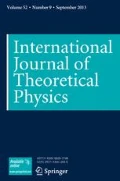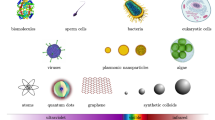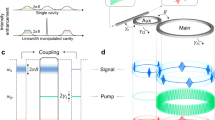Abstract
Although many quantum correlation criteria have been proposed successively in recent years, it is still an open question how to observe these criteria with the non–Hermitian terms in themselves. We propose an indirect scheme in this paper to observe non-Hermitian criteria and to judge whether or not quantum correlation exists in the system even though the expectation value measurement of non-Hermitian operator is invalid in quantum mechanics system. Our idea is to establish a critical state of mesoscopic oscillator under mean–field approximation, and the oscillator state will take place transition when the quantum correlation destroys the mean–field approximation. The non–Hermitian measurement will replace the position measurement in this process and it can be seen as a non–destructive detection. We give an example to explain this idea in a designed mesoscopic optomechanical system.






Similar content being viewed by others
References
Galindo, A., Martín-Delgado, M.A.: Rev. Mod. Phys 74, 347 (2002)
Braunstein, S.L.: Rev. Mod. Phys 77, 513 (2005)
Clader, B.D.: Phys. Rev. A 90, 012324 (2014)
Qin, W., Wang, C., Cao, Y., Long, G.L.: Phys. Rev. A 89, 062314 (2014)
Kraus, B., Cirac, J.I.: Phys. Rev. Lett. 92, 013602 (2004)
Ber, R., Kenneth, O., Reznik, B.: Phys. Rev. A 91, 052312 (2015)
Wang, S., Hou, L.L., Chen, X.F., Xu, X.F.: Phys. Rev. A 91, 063832 (2015)
Wang, T.Y., Yu, S., Zhang, Y.C., Gu, W.Y., Guo, H.: J. Phys. B: At. Mol. Opt. Phys 47, 215504 (2014)
Simon, R.: Phys. Rev. Lett. 84, 2726 (2000)
Duan, L.M.: Phys. Rev. Lett. 84, 2722 (2000)
Adesso, G., Datta, A.: Phys. Rev. Lett. 105, 030501 (2010)
Hillery, M., Zubairy, M.S.: Phys. Rev. A 74, 032333 (2006)
〈...〉 denotes taking the operator expectation value with respect to the quantum state.
Sun, Q.Q., Nha, H., Zubairy, M.S.: Phys. Rev. A 80(R), 020101 (2009)
Hillery, M., Dung, H.T., Zheng, H.J.: Phys. Rev. A 81, 062322 (2010)
Aspelmeyer, M., Kippenberg, T. J., Marquardt, F.: Rev. Mod. Phys. 86, 1391 (2015)
Farace, A., Giovannetti, V.: Phys. Rev. A 86, 013820 (2012)
Larson, J., Horsdal, M.: Phys. Rev. A 84(R), 021804 (2011)
Mari, A., Farace, A., Didier, N., Giovannetti, V., Fazio, R.: Phys. Rev. Lett 111, 103605–5 (2013)
Wang, X.: J. Phys. A 35, 165 (2002)
Zhang, F.Y., Yang, C.P., He, X.L., Song, H.S.: Phys. Lett. A 378, 1536 (2014)
Mari, A., Eisert, J.: Phys. Rev. Lett. 108, 120602 (2012)
Genes, C., Mari, A., Vitalii, D., Tombesi, S.: Adv. At. Mol. Opt. Phys. 57, 33 (2009)
Wang, Y.D., Clerk, A.A.: Phys. Rev. Lett. 110, 253601 (2013)
Gardiner, C.W., Zoller, P.: Quantum Noise. Springer, Berlin (2000)
Giovannetti, V., Vitali, D.: Phys. Rev. A 63, 023812 (2001)
Liu, Y.C., Shen, Y.F., Gong, Q.H., Xiao, Y.F.: Phys. Rev. A 89, 053821–8 (2014)
Kale, Y.B., Mishra, S.R., Tiwari, V.B., Singh, S., Rawat, H.S.: Phys. Rev. A 91, 053852–8 (2015)
Huang, S.M., Agarwal, G.S.: Phys. Rev. A 83, 023823 (2011)
Seok, H., Buchmann, L.F., Wright, E.M., Meystre, P.: Phys. Rev. A 88, 063850 (2013)
Gong, Z.R., Ian, H., Liu, Y.X., Sun, C.P., Nori, F.: Phys. Rev. A 80, 065801 (2009)
Zhang, W.Z., Cheng, J., Zhou, L.: J. Phys. B: At. Mol. Opt. Phys. 48, 015502 (2015)
Wei, J., Norman, E.: J. Math. Phys. 4, 575 (1963)
Chen, L.B., Yang, W.: Laser Phys. Lett. 11, 105201 (2014)
Wang, H.F., Wen, J.J., Zhu, A.D., Zhang, S., Yeon, K.H.: Phys. Lett. A 377, 2870 (2013)
Kuzmak, A.R., Tkachuk, V.M.: Phys. Lett. A 378, 1469 (2014)
Acknowledgments
All authors thank Jiong Cheng, Wenzhao Zhang and Yang Zhang for the useful discussion. This research was supported by the National Natural Science Foundation of China (Grant No 11175033, 11447135) and the Fundamental Research Funds for the Central Universities (DUT13LK05, DC201502080407).
Author information
Authors and Affiliations
Corresponding author
Appendices
Appendix A: Derivation Method of the Effective Hamiltonian
In this appendix, we show the derivation method corresponding to our effective Hamiltonian. The quantum Langevin equations in (7) can be rewritten in following form after completing a second quantization on the mode of oscillator and neglecting the drive:
Here \(g^{\prime }_{l}=g_{l}/\sqrt {2}\), and we directly eliminate mode c because g l and g n are both much less than 1. b(b †) is the annihilation (creation) operator of the phonon, which satisfies \(\hat {q}=(b^{\dagger }+b)/\sqrt {2}\) and \(\hat {p}=i(b^{\dagger }-b)/\sqrt {2}\). Then the general solution of this equation set can be expressed as
In our model, we set γ, |Δ i |≫g l , then the influence causing by optomechanical interaction can be regarded as perturbation for the whole system. In this case, the dynamics of a 1 and a 2 can be roughly treated as independent evolutions, i.e.,
Here \(A_{1}^{in}\) and \(A_{2}^{in}\) are modified noise terms. Using (A3), b(t) and b †(t) can be obtained as follows:
Completing the integral in (A4) and setting Δ1≃Δ2≃Δ, we can obtain:
Using the relationship of exp=(−2κ 1 t)= exp=(−κ 1 + iΔ−κ 1−iΔ)t . Then (A5) can be simplified by using (A3) retroactively:
In (A6), exp(−γ−i ω m )t is a high frequency term with fast decaying. Therefore, b(0) exp(−γ−i ω m )t and b †(0) exp(−γ + i ω m )t can be neglected. Then b(t) and b †(t) can be only expressed by a 1 and a 2. Substituting (A6) into (A1), the Langevin equations can be written as:
Based on (A7), we can finally get an effective Hamiltonian via a reverse derivation:
(A8) is exactly equal to (12) in Section 4 if we ignore the shift term \(4g_{eff}a^{\dagger }_{1}a_{1}a^{\dagger }_{2}a_{2}\) and reconsider the drive term \(iE_{l}(a_{1}^{\dagger }-a_{1})+iE_{l}(a_{2}^{\dagger }-a_{2})\).
Appendix B: Simplification of Time Evolution Operator
In this appendix, we show the simplification processing corresponding to the time evolution operator. A general time evolution operator can be written as U = exp(−i H t). One can easily rewrite it in the form of \(H=i\frac {dU}{dt}U^{-1}\) with U(0) = I. Because the bosonic operators \(\{a^{\dagger }_{j},a_{j},\hat {I}\}\) in (16) will form a closed Lie algebra, Wei–Norman algebra requires that the time–dependent parameters in (17) should satisfy:
with the initial conditions g 1(0) = g 2(0) = g 3(0)=0. The solutions of (B1) are the exactly same with (18) in Section 4.
When the translation operator \(\mathcal {D}(g_{12}(t))\) in (19) acting on an initial state |α〉 is considered and if α is real, one can get:
Now, the relative phase in (20) can be conveniently calculated.
Rights and permissions
About this article
Cite this article
Li, W., Zhang, F., Li, C. et al. Observation of Non-Hermitian Quantum Correlation Criterion in Mesoscopic Optomechanical System. Int J Theor Phys 55, 2097–2109 (2016). https://doi.org/10.1007/s10773-015-2849-y
Received:
Accepted:
Published:
Issue Date:
DOI: https://doi.org/10.1007/s10773-015-2849-y




